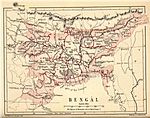Baro-Bhuyan | |
|---|---|
![Baro Bhuyan of Bengal [1]](http://upload.wikimedia.org/wikipedia/commons/thumb/8/85/Baro_Bhuyan_of_Bengal.jpg/250px-Baro_Bhuyan_of_Bengal.jpg) Baro Bhuyan of Bengal [1] | |
| Status | Confederacy of states |
| Formation | |
• Assam - Invasion of Ghiyasuddin Iwaj Shah | 1200s |
• Bengal - Mughal conquest of Bengal | 1572-1612 |
| Today part of | |
| Part of a series on the |
| History of Assam |
|---|
 |
| Categories |
| History of Bengal |
|---|
 |
The Baro-Bhuyans (or Baro-Bhuyan Raj; also Baro-Bhuians and Baro-Bhuiyans) mean twelve landlords, were confederacies of soldier-landowners in Assam and Bengal in the Medieval period. The confederacies consisted of loosely independent entities, each led by a warrior chief or a landlord. The tradition of Baro-Bhuyan is peculiar to both Assam and Bengal.[2] In Assam, this phenomenon came into prominence in the 13th century when they resisted the invasion of Ghiyasuddin Iwaj Shah and in Bengal when they resisted Mughal rule in the 16th century.[3][4]
Baro denotes the number twelve, but in general there were more than twelve chiefs or landlords, and the word baro meant many.[5] Thus, Bhuyan-raj denoted individual Bhuyanship, whereas Baro-Bhuyan denoted temporary confederacies that they formed.[6] In times of aggression by external powers, they generally cooperated in defending and expelling the aggressor. In times of peace, they maintained their respective sovereignty. In the presence of a strong king, they offered their allegiance.[7] In general each of them were in control of a group of villages, called cakala, and the more powerful among them called themselves raja.[8] The rulers of the Bhuyanships belonged to different ethnic, religious or social backgrounds.[9][10]
In 13th century Brahmaputra valley the system of Baro-Bhuyan Raj (confederacy) was formed from the petty chieftains—the remaining fragments of the erstwhile Kamarupa state.[6][11] They often resisted foreign invasions (Ghiyasuddin Iwaj Shah in the 13th century), removed foreign rule (Hussain Shah in the 16th century) and sometimes usurped state power (Arimatta in the 14th century). They occupied the region west of the Kachari kingdom in the south bank of the Brahmaputra river, and west of the Chutiya kingdom in the north bank. These included areas of Nagaon, Darrang and Sonitpur districts. Subsequently, the Baro Bhuyan rule ended in the 16th century as they were squeezed between the Kachari kingdom and the Kamata kingdom in the west and were slowly overpowered by the expanding Ahom kingdom in the east.
In Bengal, the most prominent Baro-Bhuyan confederacy was led by Isa Khan of Sonargaon in the 16th century, which emerged during the disintegration of the Bengal Sultanate in the region, as a resistance to the Mughal expansion.[12] They carved the land of Bhati and other areas of Bengal into twelve administrative units or Dwadas Bangla.[13] The Baro-Bhuyans gradually succumbed to the Mughal dominance and eventually lost control during the reign of emperor Jahangir, under the leadership of Islam Khan I, the governor of Bengal Subah.[14]
- ^ Abdul Karim (2012). "Bara Bhuiyans, The". In Sirajul Islam; Miah, Sajahan; Khanam, Mahfuza; Ahmed, Sabbir (eds.). Banglapedia: the National Encyclopedia of Bangladesh (Online ed.). Dhaka, Bangladesh: Banglapedia Trust, Asiatic Society of Bangladesh. URL. URL Archive. ISBN 984-32-0576-6. OCLC 52727562. OL 30677644M
- ^ "The tradition of Bara Bhuyan is peculiarly common to both Assam and Bengal." (Neog 1992:63)
- ^ "Some of the Bara Bhuyans of Bengal are mentioned in the Akbar-namah and Ain-i-Akbari so that the institution seems to have been in existence even before the times of Akbar." (Neog 1992:63)
- ^ "The Bara Bhuyans of Kamarupa played a similar role in the country's history round about the thirteenth century...Jadunath Sarkar holds that Husamuddin Iwaz (c. 1213–1227) reduced some of the Barabhuyans to submission when he attacked Kamarupa." (Neog 1992:63–64)
- ^ (Neog 1980:49f)
- ^ a b "In the 13th century, the Indo-Aryan culture still dominated the lives of a major section of the population in the central plains of the Brahmaputra Valley. However, nothing was left of the ancient state of Kamarupa at that juncture, except for what fragments remained of it in the form of petty chiefdoms. The petty chiefs were called bhuyan many of whom were migrant adventurers from North India. The rule by a bhuyan was called bhuyan-raj and their temporary confederacies were known as bara-bhuyan raj."(Guha 1983:10)
- ^ (Neog 1980, p. 49)
- ^ (Neog 1980, p. 48)
- ^ "The territories under the Bhuyans, a growing landlord class, mostly belonging to the Brahmanas and Kayasthas, in the middle of the valley on both banks of the Brahmaputra"(Sarma 2010:243)
- ^ "It is usually believed that the Bhuyans constituted a Hindu caste. But the Darrang Raj Vamshavali, as well as in Persian sources like the Akbarnama and the Ain-i-Akbari, there are references to Muslim Bhuyans as well. This confirms that the Bhuyans were a class rather than a caste."(Nath 1989:21)
- ^ "The Karatoya on the western border is a well-known river now flowing through the Jalpaiguri District of West Bengal and the Rangpur and Bogra Districts of Bangladesh while the junction of the Brahmaputra and the Laksha (modern Lakhya) at the southern boundary now stands near the border between near the border between the Dacca and Mymensingh Districts of Bangladesh." (Sircar 1990:63)
- ^ Cite error: The named reference
:0was invoked but never defined (see the help page). - ^ Akbarnama, Volume III, Page 647
- ^ "History". Banglapedia. Archived from the original on 29 September 2017. Retrieved 23 September 2017.
Shah-i-Bangalah, Shah-i-Bangaliyan and Sultan-i-Bangalah
